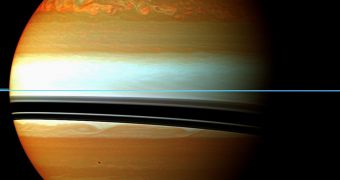In 2010, a massive storm erupted on Saturn. This is not that unregular, but if you think hurricanes are long lasting, this storm endured for two years before finally receding. In fact, its remnants can still be seen, though only in infrared light.
The storm caused a huge disturbance in Saturn's upper atmosphere and could be seen by amateur astronomers on Earth. While the turbulences were quite spectacular in visible light, the storm was even more interesting in infrared light.
Thankfully, Cassini was on site and was careful to record the entire event. Now it's tracking the aftermath which is proving surprising to astronomers.
The temperature of Saturn's stratosphere shot up by 83 degrees Celsius/Kelvin or 150 degrees Fahrenheit in the region affected by the storm, even after the visible signs were gone, Cassini's CIRS (composite infrared spectrometer) discovered.
After the storm died down, astronomers saw two beacons of hot "air" that lingered. The two beacons eventually merged, as you can see in the video, and the temperature of this combined mass went up to -64 degrees Fahrenheit, or -53 degrees Celsius.
That's not all – a huge release of ethylene, 100 times more than scientists believed was even possible on Saturn, was discovered in the aftermath.

 14 DAY TRIAL //
14 DAY TRIAL //